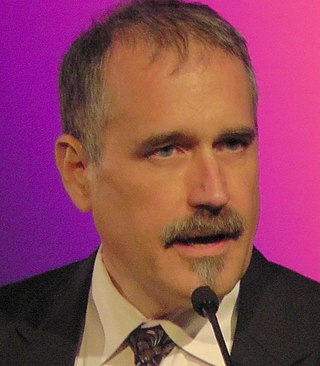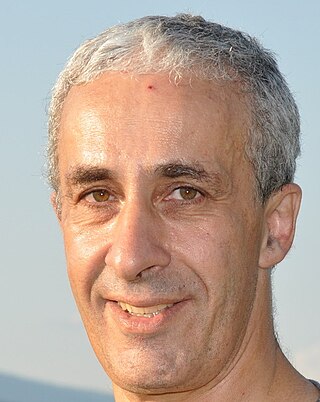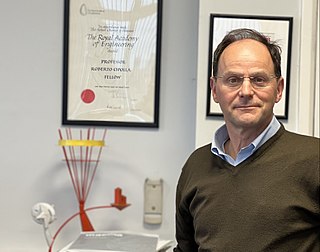Related Research Articles
Random sample consensus (RANSAC) is an iterative method to estimate parameters of a mathematical model from a set of observed data that contains outliers, when outliers are to be accorded no influence on the values of the estimates. Therefore, it also can be interpreted as an outlier detection method. It is a non-deterministic algorithm in the sense that it produces a reasonable result only with a certain probability, with this probability increasing as more iterations are allowed. The algorithm was first published by Fischler and Bolles at SRI International in 1981. They used RANSAC to solve the Location Determination Problem (LDP), where the goal is to determine the points in the space that project onto an image into a set of landmarks with known locations.
Michael Irwin Jordan is an American scientist, professor at the University of California, Berkeley and researcher in machine learning, statistics, and artificial intelligence.
The following outline is provided as an overview of and topical guide to computer vision:
Andrew Zisserman is a British computer scientist and a professor at the University of Oxford, and a researcher in computer vision. As of 2014 he is affiliated with DeepMind.

Alan Conrad Bovik is an American engineer, vision scientist, and educator. He is a professor at the University of Texas at Austin (UT-Austin), where he holds the Cockrell Family Regents Endowed Chair in the Cockrell School of Engineering and is Director of the Laboratory for Image and Video Engineering (LIVE). He is a faculty member in the UT-Austin Department of Electrical and Computer Engineering, the Machine Learning Laboratory, the Institute for Neuroscience, and the Wireless Networking and Communications Group.
The International Conference on Computer Vision (ICCV) is a research conference sponsored by the Institute of Electrical and Electronics Engineers (IEEE) held every other year. It is considered to be one of the top conferences in computer vision, alongside CVPR and ECCV, and it is held on years in which ECCV is not.
Maria Petrou FREng was a Greek-born British scientist who specialised in the fields of artificial intelligence and machine vision. She developed a number of novel image recognition techniques, taught at Surrey University and Imperial College London, and was a prolific author of scientific articles.

John O'Keefe, is an American-British neuroscientist, psychologist and a professor at the Sainsbury Wellcome Centre for Neural Circuits and Behaviour and the Research Department of Cell and Developmental Biology at University College London. He discovered place cells in the hippocampus, and that they show a specific kind of temporal coding in the form of theta phase precession. He shared the Nobel Prize in Physiology or Medicine in 2014, together with May-Britt Moser and Edvard Moser; he has received several other awards. He has worked at University College London for his entire career, but also held a part-time chair at the Norwegian University of Science and Technology at the behest of his Norwegian collaborators, the Mosers.

BMVA Summer School is an annual summer school on computer vision, organised by the British Machine Vision Association and Society for Pattern Recognition (BMVA). The course is residential, usually held over five days, and consists of lectures and practicals in topics in image processing, computer vision, pattern recognition. It is intended that the course will complement and extend the material in existing technical courses that many students/researchers will encounter in their early stage of postgraduate training or careers. It aims to broaden awareness of knowledge and techniques in Vision, Image Computing and Pattern Recognition, and to develop appropriate research skills, and for students to interact with their peers, and to make contacts among those who will be the active researchers of their own generation. It is open to students from both UK and non-UK universities. The registration fees vary based on time of registration and are in general slightly higher for non-UK students. The summer school has been hosted locally by various universities in UK that carry out Computer Vision research, e.g., Kingston University, the University of Manchester, Swansea University and University of Lincoln.
Medical Image Understanding and Analysis (MIUA) is a UK-based meeting for the communication of research related to image analysis and its application to medical imaging and biomedicine. The meetings provide an opportunity to present and discuss research in medical image understanding and analysis; a rapidly growing subject with ever increasing real-world applicability.
John D. Lafferty is an American scientist, Professor at Yale University and leading researcher in machine learning. He is best known for proposing the Conditional Random Fields with Andrew McCallum and Fernando C.N. Pereira.
Pushmeet Kohli is a computer scientist at Google DeepMind where he holds the position of Vice President of research for the "Secure and Reliable AI" and "AI for Science and Sustainability". Before joining DeepMind, he was partner scientist and director of research at Microsoft Research and a post-doctoral fellow at the University of Cambridge. Kohli's research investigates applications of machine learning and computer vision. He has also made contributions in game theory, discrete algorithms and psychometrics.
P. J. Narayanan is a professor at the International Institute of Information Technology, Hyderabad, and the institute's current director since April 2013. He is known for his work in computer vision, computer graphics, and parallel computing on the GPU.

Pascal Fua is a computer science professor at EPFL. He received an engineering degree from École Polytechnique, Paris, in 1984 and a Ph.D. in computer science from the University of Orsay in 1989. He joined EPFL in 1996. Before that, he worked at SRI International and at INRIA Sophia-Antipolis as a computer scientist.
Andrew Fitzgibbon FREng is an Irish researcher in computer vision. Since 2022, he has worked at Graphcore.
Michal Irani is a professor in the Department of Computer Science and Applied Mathematics at the Weizmann Institute of Science, Israel.
Lourdes de Agapito Vicente is British computer scientist and academic. She is Professor of 3D Vision in the department of computer science at University College London (UCL), where she leads a research group with a focus on 3D dynamic scene understanding from video. Agapito is the co-founder of the software company Synthesia, and an elected member of the Executive Committee of the British Machine Vision Association.
Tamara Lee Berg is a tenured associate professor at the University of North Carolina at Chapel Hill and a research scientist manager at Facebook AML/FAIR.

Roberto Cipolla, FREng, is a British researcher in computer vision and Professor of Information Engineering at the University of Cambridge.
References
- ↑ "The British Machine Vision Conference (BMVC)". British Machine Vision Association.
- ↑ "BMVC". Conference Ranks. Retrieved 2014-12-15.
- 1 2 "CORE Conference Portal". Computing Research and Education Association of Australasia, CORE Inc. Retrieved 2023-12-01.
- ↑ "Qualis Conferências - Ciência da Computação - 2016" (PDF). Coordenação de Aperfeiçoamento de Pessoal de Nível Superior (CAPES). Retrieved 2018-12-12.
- ↑ "The 34th British Machine Vision Conference 2023: Home" . Retrieved 2023-12-01.
- 1 2 "BMVC Statistics". BMVA. Archived from the original on 2019-03-27. Retrieved 2019-03-28.
- ↑ "BMVC 2012 Conference Programme". University of Surrey. Archived from the original on 2014-12-15. Retrieved 2014-12-15.
- ↑ "BMVC 2013 - Final Programme". University of Bristol . Retrieved 2014-12-15.
- ↑ "BMVC 2014 Programme" (PDF). University of Nottingham . Retrieved 2014-12-15.
- ↑ Pete Mowforth (1991). BMVC'91 - Chairman's report, BMVA News, Volume 2 Number 4
- 1 2 3 "Tim Cootes: Publications". University of Manchester . Retrieved 2014-12-15.
- ↑ "Jana Novovičová - Scientific Awards". Czech Academy of Sciences . Retrieved 2014-12-15.
- ↑ "Profile - Cham, Tat-Jen". Nanyang Technological University. Retrieved 2014-12-15.
- 1 2 Kazuki Kozuka, Cheng Wan and Jun Sato (2008). Rectification of 3D data obtained from moving range sensor by using extended projective multiple view geometry (section Biography of Jun Sato). International Journal of Automation and Computing, Volume 5, Issue 3, p. 275.
- ↑ Tony Lacey (1994). BMVC'94, BMVA News, Volume 5 Number 3
- ↑ "An Integrated Traffic and Pedestrian Vision System: Papers". University of Leeds. Archived from the original on 2015-09-24. Retrieved 2014-12-15.
- ↑ "Springer in China - TAN Tienu". Springer . Retrieved 2014-12-15.
- 1 2 Mark Nixon (1998). The Ninth British Machine Vision Conference, BMVA News, Volume 9 Number 2
- ↑ "Alexandra Psarrou - Publications". University of Westminster . Retrieved 2014-12-15.
- ↑ "Queen Mary Vision Group - Dynamic Face Models". Queen Mary University of London . Retrieved 2014-12-15.
- ↑ "Aphrodite Galata -- Publications". University of Manchester . Retrieved 2014-12-15.
- 1 2 Maria Petrou (2000). Prizes at BMVC 2000, BMVA News, Volume 11 Number 2
- 1 2 3 Maria Petrou (2001). Prizes at BMVC 2001, BMVA News, Volume 12 Number 1
- 1 2 3 4 Maria Petrou (2002). Prizes at BMVC 2002, BMVA News, Volume 13 Number 1
- 1 2 3 Richard Harvey (2003). Report on BMVC 2003, BMVA News, Volume 14 Number 1
- ↑ "BMVC Best Paper Awards". VisionWang: Computer Vision Expert Blog. Retrieved 2014-12-15.
- 1 2 3 T.J. Ellis (2003). BMVC 2004 Prizes and Awards, BMVA News, Volume 15 Number 1
- ↑ Andrew Fitzgibbon (2005). BMVC Prizes, BMVA News, Volume 16 Number 1
- ↑ Mike Chantler (2006). Prizes awarded at BMVC 2006, BMVA News, Volume 17 Number 1
- 1 2 Majid Mirmehdi (2007). Prizes and Awards, BMVA News, Volume 18 Number 1
- 1 2 "BMVC2007 Warwick - Prizes and Awards". University of Warwick . Retrieved 2014-12-15.
- 1 2 3 Mark Everingham (2008). Prizes and Awards at BMVC 2008, BMVA News, Volume 19 Number 1
- 1 2 3 "BMVC 2008 - Awards and Prizes". University of Leeds . Retrieved 2014-12-15.
- ↑ Simon J.D. Prince (2009). Summary of Prizes Presented at BMVC 2009, BMVA News, Volume 20 Number 1
- 1 2 3 Roy Davies (2010). Prizes and Awards at BMVC 2010, BMVA News, Volume 21 Number 1
- 1 2 3 4 Stephen McKenna (2011). Prizes and Awards at BMVC 2011, BMVA News, Volume 22 Number 1
- 1 2 3 4 5 Krystian Mikolajczyk (2012). Prizes and Awards at BMVC 2012, BMVA News, Volume 23 Number 1
- 1 2 Dima Damen (2013). Prizes and Awards at BMVC 2013, BMVA News, Volume 24 Number 1
- 1 2 "BMVC 2014 - British Machine Vision Conference". University of Nottingham . Retrieved 2014-12-15.
- ↑ "26th British Machine Vision Conference". Swansea University . Retrieved 2016-08-05.
- ↑ "BMVC 2016" . Retrieved 2016-08-05.
- ↑ "BMVC 2017" . Retrieved 2017-10-24.
- ↑ "BMVC 2018" . Retrieved 2018-09-03.
- ↑ "BMVC 2019" . Retrieved 2019-04-04.
- ↑ Tim Cootes (2001). BMVC 2001 Presentation Prize, BMVA News, Volume 12 Number 2